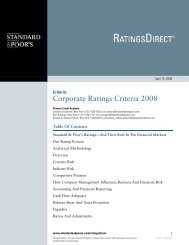European Infrastructure Finance Yearbook - Investing In Bonds ...
European Infrastructure Finance Yearbook - Investing In Bonds ...
European Infrastructure Finance Yearbook - Investing In Bonds ...
Create successful ePaper yourself
Turn your PDF publications into a flip-book with our unique Google optimized e-Paper software.
TRANSPORTATION INFRASTRUCTURE<br />
58 ■ NOVEMBER 2007<br />
constraints. Although the U.K. Aviation White<br />
Paper “The Future of Air Transport” (the White<br />
Paper), published in December 2003, proposes the<br />
construction of a third runway at Heathrow and<br />
additional terminal capacity, this is only expected<br />
by 2015-2020 if environmental conditions are<br />
met and the planning process runs smoothly.<br />
Aeronautical activity<br />
BAA is forecasting average passenger traffic<br />
growth for its three designated airports of 2.8%<br />
per year over the 2007-2018 period. This is below<br />
the expected natural growth rate in England of<br />
4.5% to 5.0%, reflecting capacity constraints at<br />
the London airports. <strong>In</strong>dustry events, erosion of<br />
passenger confidence, and a weak economic<br />
climate, could result in lower-than-expected<br />
passenger growth. Our long-term scenario is<br />
annual passenger growth of about 2%.<br />
Historical trends have demonstrated the<br />
stability of aeronautical activity at BAA’s airports<br />
and the increasing resilience of passenger demand<br />
behavior to external shocks. This supports BAA’s<br />
business profile. BAA has a record of more than<br />
40 years of almost continual traffic growth.<br />
During this period, only the years following the<br />
first oil crisis in 1974, the 1991 Gulf War, and the<br />
events of Sept. 11, 2001 showed traffic decreases.<br />
Nevertheless, with the exception of 1991, when<br />
traffic decreased by 7%, the rate of passenger<br />
volume decline was in the low single digits and<br />
was short lived.<br />
Since the beginning of the 2003-2008<br />
regulatory period, traffic performance at the<br />
designated airports has been mixed. BAA’s<br />
designated airports underperformed the<br />
regulatory assumptions in the fiscal years ended<br />
March 31, 2006, and Dec. 31, 2006 (the<br />
company’s fiscal year-end was changed during<br />
2006; see “Accounting” section), and<br />
outperformed the U.K. Civil Aviation Authority’s<br />
(CAA) assumptions in 2005. Based on first-half<br />
traffic figures, 2007 is likely to be below the<br />
CAA’s assumptions.<br />
<strong>In</strong> the first six months of fiscal 2007, traffic at<br />
BAA’s regulated airports was stable compared<br />
with the same period of the previous year, after a<br />
decline of 0.6% in June 2006. Performance at<br />
group level was stronger, with passenger growth<br />
at 0.5% (below the 1.1% increase in the 12<br />
month rolling period to June 2007), thanks to the<br />
STANDARD & POOR’S EUROPEAN INFRASTRUCTURE FINANCE YEARBOOK<br />
performance of Southampton and the Scottish<br />
airports, which saw growth of 3.2% and 3.5%,<br />
respectively, over the period. The recent attempted<br />
terrorist attack at Glasgow airport contributed to<br />
a fall of 2.4% in June 2007, as more than 60% of<br />
flights were cancelled or diverted when the airport<br />
was temporarily closed in the immediate<br />
aftermath of the incident. Less than 24 hours<br />
after the incident the airport was reopened and<br />
operating a full flight schedule.<br />
A diversified airline, destination, and passenger<br />
mix supports traffic stability at BAA’s airports.<br />
Customer concentration and dependence on the<br />
lower rated airline sector are perceived as<br />
weaknesses for airports in general, when<br />
compared with gas and water utilities.<br />
Nevertheless, airports with strong competitive<br />
positions are partially insulated from this risk, as<br />
the strength of routes is key for traffic stability. If<br />
there is sufficient demand for a particular<br />
destination, it is expected that a failing airline<br />
serving that route would be substituted. Although<br />
BAA’s four largest customers contribute about<br />
one-half of its designated airports’ passenger<br />
traffic (the revenue contribution is lower),<br />
customer concentration is not perceived as a<br />
credit risk, particularly at Heathrow, where<br />
demand for slots exceeds supply. Of the hub<br />
airport operators rated by Standard & Poor’s,<br />
BAA has the lowest exposure to its flag carrier.<br />
For the nine months ended December 2006, 27%<br />
of total passenger traffic came from British<br />
Airways PLC (BBB-/Stable/--) (Heathrow 41%,<br />
Gatwick 21%). <strong>In</strong> comparison, Air France-KLM<br />
represented more than 50% of passengers at<br />
Aeroports de Paris (AA-/Stable/--) and more than<br />
60% at Schiphol (N.V. Luchthaven Schiphol and<br />
Schiphol Nederland B.V.; AA-/Negative/--).<br />
Each of BAA’s larger airports caters for different<br />
segments of the aviation market. This<br />
diversification is supportive of BAA’s business<br />
profile because the negative effects of a downturn<br />
in one segment can be offset by strong<br />
performance in others. Heathrow is the largest<br />
hub in Europe, and almost all carriers are<br />
scheduled rather than charter, while Gatwick is<br />
the main U.K. charter airport, with a growing<br />
low-cost carrier presence. Stansted is an origin<br />
and destination airport and the U.K. center for<br />
the low-cost airline business. Stansted’s rapid<br />
growth rates over the past 10 years result from



